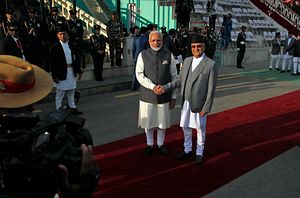KATHMANDU — The fourth heads-of-state summit of the Bay of Bengal Initiative for Multi-Sectoral Technical and Economic Cooperation (BIMSTEC) in Kathmandu on August 30 and 31 will bring together seven countries, five from South Asia (Bangladesh, Bhutan, India, Nepal, and Sri Lanka) and two from Southeast Asia (Myanmar and Thailand). BIMSTEC, formed in 1997 in Bangkok, had been moribund for much of its existence, with the last summit held in Naypyidaw, Myanmar in March 2014. Lately, however, the forum has gotten a new lease on life thanks to India’s renewed interest.
India, by far the largest country both economically and militarily in BIMSTEC, has tried to promote the forum in lieu of the South Asian Association for Regional Cooperation (SAARC), the eight-country grouping which includes Afghanistan, Bhutan, Bangladesh, India, the Maldives, Nepal, Pakistan, and Sri Lanka as members. The reason for the switch is the growing realization in New Delhi that the India-Pakistan rivalry will never allow for meaningful regional cooperation from within the SAARC framework.
All the major decisions in SAARC, which has been in existence since 1985, have to be taken by consensus. Because India and Pakistan seldom accept each other’s proposals, there has been little headway made in terms of bringing South Asia closer economically. India refused to take part in the 19th SAARC summit that had been scheduled for Islamabad in 2016, saying that there would be no engagement with Pakistan unless the latter stopped providing safe haven to terrorists. India now seems intent on pushing regional initiatives like BIMSTEC that do not include Pakistan.
But while Pakistan could arguably have done more to rein in anti-India terrorism that originates on its soil, India’s overall role within SAARC has also been dubious. When SAARC was founded under the initiative of Bangladesh and Nepal, India suspected smaller countries in the region were trying to “gang up” against New Delhi. Hence, India has never been keen on SAARC. Perennial India-Pakistan tensions only made the situation worse.
Yet there continues to be considerable goodwill for SAARC in its smaller member states like Nepal. Traditionally, Nepal has seen SAARC as a forum where it could stand as an equal with India, the “big brother” next door. There is also a feeling that India, the undisputed fulcrum of South Asia, could have done more to promote regional cooperation in South Asia (despite Pakistan’s less-than-helpful attitude). This is why many analysts in Kathmandu are suspicious of India’s intent behind its backing of BIMSTEC.
Most don’t expect anything substantial to come out of the fourth BIMSTEC summit Nepal is hosting. After all, BIMSTEC has not managed to draft a guiding charter in over two decades of existence. Interestingly, the Nepal government has already started chalking up successes on the bilateral front with India, like rail and road connectivity projects, as prospective BIMSTEC success stories. This means Nepal will allow India to place many of these bilateral projects under BIMSTEC, just like it has allowed China to club most of its bilateral projects with Nepal under the Belt and Road Initiative (BRI).
The China factor is vital. During the last SAARC summit in Kathmandu in 2014, Nepal, with Pakistan’s support, had proposed that China be included as a full SAARC member state, a development that India did not appreciate. Traditionally, India has seen South Asia as its backyard and has not been ready to let in a third party. There was a perception in New Delhi that Beijing was looking to spread its footprints in South Asia via SAARC. This is another reason Indian Prime Minister Narendra Modi wanted to revive BIMSTEC, which, unlike SAARC, has a distinct anti-China whiff.
With this background, Nepal’s foreign policy of late has been rather curious. New Nepali Prime Minister K.P. Sharma Oli seems to believe that if he has both India and China on board he does not need the rest of the international community. So as Sino-India ties have warmed, Oli has relentlessly pushed the idea of Nepal-India-China trilateral cooperation. Before, the Indians did not even want to hear of it. Now they are more sympathetic.
Nepal will hence look to derive maximum benefit from China’s BRI, while also not desisting from using multilateral forums like BIMSTEC to enhance ties with India. This may not be wise. India and China have never cooperated for a third country’s benefit in South Asia, and it would be naïve to think they will do so for Nepal. But Oli is determined to give it a go.
Just as joining the BRI helped Oli curry the favor with the Chinese, he seems to believe that following India’s lead on BIMSTEC will help him cement ties with the Indian establishment. With both India and China on his side, he will also feel he has enough international support to serve out his five-year term. (Nepali governments have often been toppled early due to India-China geopolitical tussles.)
On the eve of the BIMSTEC summit, the big question that is being asked in Kathmandu is whether India is ready to overcome its security sensitivities and allow Nepali trucks and trains to use its territory to directly connect with Bangladesh and Myanmar. If not, BIMSTEC will prove to be no more than a geopolitical chessboard for bigger powers, and one which has little room for smaller players in the region like Nepal.
Biswas Baral is a Nepali journalist who writes on geopolitics. He tweets @biswasktm

































